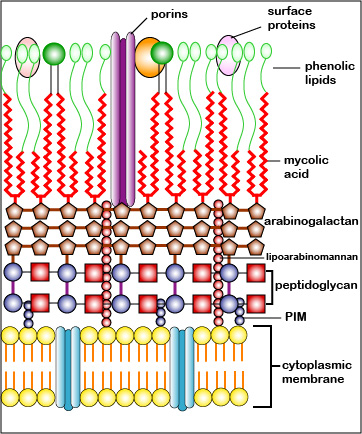
In addition to peptidoglycan, the acid-fast cell wall of Mycobacterium contains a large amount of glycolipids, especially mycolic acids. The peptidoglycan layer is linked to arabinogalactan (D-arabinose and D-galactose) which is then linked to high-molecular weight mycolic acids. The arabinogalactan/mycolic acid layer is overlaid with a layer of polypeptides and mycolic acids consisting of free lipids, phenolic glycolipids, and peptidoglycolipids. Other glycolipids include lipoarabinomannan and phosphatidyinositol mannosides (PIM). Like the outer membrane of the gram-negative cell wall, porins are required to transport small hydrophilic molecules through the outer membrane of the acid-fast cell wall. Because of its unique cell wall, when it is stained by the acid-fast procedure, it will resist decolorization with acid-alcohol and stain red, the color of the initial stain, carbol fuchsin. With the exception of a very few other acid-fast bacteria such as Nocardia, all other bacteria will be decolorized and stain blue, the color of the methylene blue counterstain.
Illustration of The Structure of an Acid-Fast
Cell Wall.jpg by Gary E. Kaiser, Ph.D.
Professor of Microbiology,
The Community College of Baltimore County, Catonsville Campus
This work is licensed under a Creative Commons Attribution 4.0 International License.
Based on a work at https://cwoer.ccbcmd.edu/science/microbiology/index_gos.html.
Last updated: Feb., 2021
Please send comments and inquiries to Dr.
Gary Kaiser